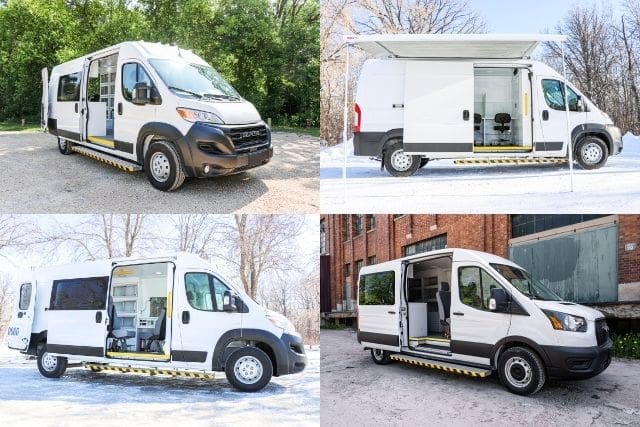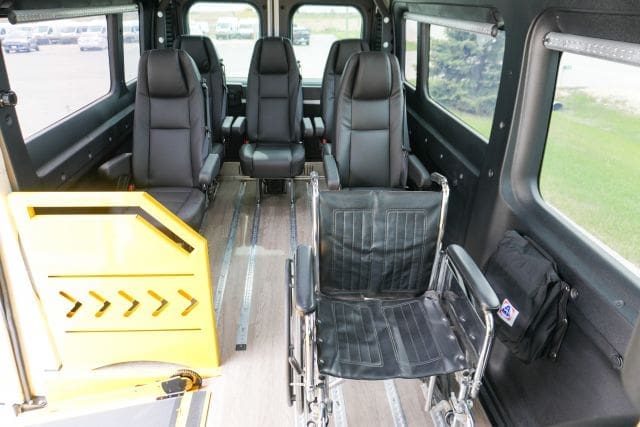Is your organization currently looking for ways to resolve barriers to healthcare across the U.S.? With over 70% of U.S. adults feeling that the healthcare system fails to meet their needs, healthcare barriers are issues that need to be looked at.
At AVAN Mobility, we specialize in manufacturing state-of-the-art mobile medical vans to help organizations eliminate many of the healthcare barriers you’ll read about in this article.
With a commitment to helping people help people, our innovative solutions have saved numerous lives, reflecting our dedication to making a positive impact in communities. It’s heartening to know that our mobile medical vans have played a pivotal role in enhancing healthcare accessibility and outcomes.
As you read this article, you’ll get a better understanding of some of the healthcare barriers people face. We’ll also leave you with a solution on how your organization can tackle these healthcare barriers and provide healthcare services to those who need them the most.
What are healthcare barriers?
Healthcare barriers are anything that prevents someone from receiving healthcare. They can range from something as simple as the weather preventing a family from making it to the hospital to something as elaborate as someone’s healthcare insurance not covering medical bills.
Healthcare barriers hurt people’s health and well-being. Try to imagine being unable to get to your destination. Healthcare barriers are similar, and they block people from receiving important medical care. When medical care is delayed, it makes it difficult for people to address their health concerns.
In the next sections, we’ll start talking about some of the barriers to healthcare that people face. If you prefer to learn by watching instead, check out the video below!
1. Transportation barriers to healthcare
Reliable transportation can be a big problem for many people trying to get healthcare. Picture someone living in a remote area who has an important medical appointment. They go to start their car on a cold winter day, and the battery is completely dead. They end up missing their appointment and aren’t able to book another one for 6 months.
Their health condition worsens over the next 6 months as they wait for their next appointment. When they do make it to their appointment, their doctor gives them an unfortunate diagnosis. They mention that they waited far too long and that preventative care is no longer an option at that point.
Consider someone with a disability. Not all types of transportation work well for people with disabilities. What if someone in a wheelchair needs to go to the hospital one day, but a regular car isn’t able to get them there? People facing transportation barriers deal with a higher risk of disease. Studies have indicated that transportation barriers to healthcare affect up to 67% of people.
Look at some of these other studies below:
- One study on cancer patients found that the ones without a vehicle were less likely to receive chemotherapy treatments.
- A study on inner-city children found that transportation barriers were the cause of up to 62% of them missing timely healthcare.
- Lastly, another study on transit accessibility in low-income counties found that 55% of patients who were late or missed appointments altogether were the direct result of transportation problems.
2. Cultural barriers to healthcare
Cultural barriers to healthcare are a big challenge that stops many people from getting the medical attention they need. Two factors associated with these barriers include:
- Stigma and discrimination: People might avoid going to the doctor because they worry about being treated unfairly based on their culture. This fear can make it hard for them to ask for and seek healthcare.
- Cultural misunderstandings: Sometimes, different customs and ways of talking can cause confusion between people and healthcare providers. This confusion makes it tricky for individuals to explain what kind of healthcare help they need.
Cultural barriers to healthcare can lead to:
- Delayed seeking of care: Cultural barriers often cause people to wait too long before getting healthcare. This delay can make health problems become more serious over time.
- Health disparities: Cultural challenges can make a big difference in health outcomes. Some cultural groups face more problems in getting good healthcare. This is especially the case if they speak a different language or are in a clinic that doesn’t understand their culture well.
Think about the following example of a cultural barrier in healthcare:
Someone from Zimbabwe who can’t speak English visits a clinic in California. They can’t properly explain their symptoms to the doctor to get the help they need. They leave the clinic feeling misunderstood and worse off than when they walked in.
3. Financial barriers to healthcare
Moving forward from cultural barriers, let’s dive into financial barriers to healthcare. This is a significant roadblock for many people who need healthcare in the U.S.
Over 60% of people feel that affordability is the largest barrier to receiving healthcare.
Healthcare costs in the U.S. are generally considered to be very high. Some sources state that U.S. healthcare costs are the highest in the world. In 2022 alone, healthcare spending totaled $4.5 trillion, and that averages more than $13,000 per person.
Many people simply don’t have enough money to pay for healthcare. This can make it tough for them to get the medical attention they need. Even if someone struggling financially wants to see a doctor, the high costs of it stop them from doing so.
As you’re probably aware, the delay in getting healthcare only makes problems worse. Financial barriers create differences in who can and cannot afford good healthcare. This means not everyone has the same access to necessary medical services.
4. Accessibility to quality healthcare facilities
The next challenge that people often face is finding quality healthcare facilities. In some remote areas of the U.S., there might not be many healthcare places nearby. This makes it hard for people to get the care they need.
Rare conditions or complex health issues require access to specialists. Specialists often have long waiting times for appointments. This delay can hinder people from receiving timely care for their conditions.
Think about someone who lives 8 hours away from the nearest medical facility and requires specialized care. The limited availability of specialized services makes it tough to receive targeted treatments. As a result, the patient is forced to deal with the dilemma of traveling 8 hours for treatment or foregoing it altogether.
5. Geographic barriers to healthcare
Some people struggle to get healthcare because of geographic barriers. Reaching a doctor is challenging if you don’t live anywhere near one. Picture living in a small, isolated town that doesn’t have a hospital. If someone gets sick or injured, they can’t just easily visit a clinic.
The delay in medical attention can turn an injury into something more serious. This also goes for something as simple as getting a vaccine or a health screening. Geographic barriers make getting healthcare much tougher than it should be.
Now, if you add transportation barriers in the mix, as we discussed earlier, it makes it even more difficult. While other healthcare options exist, such as telehealth, what if people don’t know how to use the technology?
What’s the solution to healthcare barriers?

When it comes to overcoming healthcare barriers, mobile medical vans are a great answer. They help with many of the problems that stop people from getting the healthcare they need. Let’s take a closer look at how they do that.
Transportation barriers: Think about the same example we mentioned earlier about someone who lives in a remote area with a dead car battery on a freezing day. Mobile medical vans fix this barrier by bringing healthcare directly to them. No long trips or worrying about cars breaking down. With these vans, everyone can get healthcare without stressing about travel problems.
Connecting with different cultures: Some folks avoid going to the doctor because they worry about how they’ll be treated based on their culture. Mobile medical vans solve this by bringing culturally sensitive healthcare straight to diverse communities. It’s more comfortable and familiar for the patients and makes it a more positive experience for people to get the healthcare they need.
Bringing quality healthcare anywhere: Finding good healthcare in rural communities can be tough. Mobile medical vans act like moving healthcare units that reach places that don’t have much access to medical care. Depending on your mobile healthcare program, they can offer specialized care right then and there.
Watch the video below about an organization that purchased a Mobile Clinic Van from us and see how it is now actively being used to overcome obstacles to people receiving healthcare in Joplin, Missouri.
How can AVAN Mobility help your organization overcome barriers to healthcare?
You came to this article to learn more about the barriers to healthcare that people around the U.S. face. After learning about these barriers, you also learned about a useful solution to overcome some of them.
At AVAN Mobility, we don’t like seeing barriers getting in the way of people accessing healthcare. Our experience manufacturing mobile medical vans spans over 10 years, and all four of them can be used for a variety of purposes. Click the button at the end of this article to reach out to a commercial mobility expert for more information on the vans.
If your organization is interested in pursuing a vehicle to help people overcome healthcare barriers, read our article on how to choose a mobile medical van.
You should also take a look at our article on how mobile medical vehicles save lives. This article will give you a closer look into the life-changing impact these vehicles have.





